Is the forecast calling for rain, but you don’t want to cancel your camping trip? Many people love the atmosphere of a rainy afternoon. However, camping in the rain is a more difficult endeavor that campers aren’t often prepared for. Fortunately, there are a few easy ways to get comfortable camping in the rain, even if you’ve never done it before.
Camping in the rain starts with choosing the right campsite and gear. You’ll need tarps, a rainfly, waterproof layers, and a bivy bag. Waterproof your tent before you leave, and pack food that can be eaten without warming. Pack lights for dark evenings and plan a hangout space outside the tent.
Camping in the rain can be a lot of fun with some tips for preparing your campsite.
How to Camp in the Rain?
If you plan to camp in the rain or think the forecast might be calling for wet weather, you’ll need to plan. Camping in the rain doesn’t have to be impossible, but it does require a little planning.
You may even have to purchase a few new items to add to your pack. Here is what you need to know about preparing to camp in the rain and what you’ll need to pack to be comfortable.
1. Choose the Right Campsite
First and foremost, selecting the right campsite is a huge deal when you know you’ll be in the rain over a long night or weekend. Scope out the best possible place for your tent before you start to set up camp.
You don’t want to position yourself where you’ll wake up in a pool of water. Look for a spot that has decent elevation and that won’t flood in the middle of the night with a heavy downpour.
Another tip is to remember not to choose a spot beneath a bunch of trees if it can be avoided. A tree will drip water on your tent or rainfly long past the point when the rain ceases to fall.
Not to mention, wet branches and heavy winds can lead to falling limbs that could cause some serious injury to campers.
Read our guide on the best spots to pitch your tent for more information.
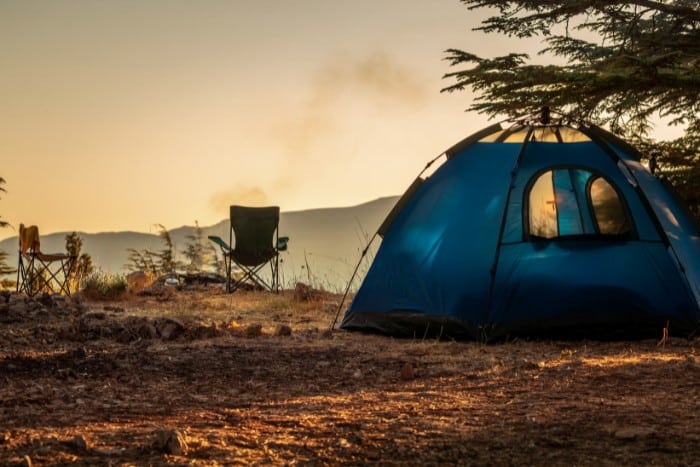
2. Find a Hangout Space
Even if you happen to wear all waterproof gear, the odds are that you and your friends don’t want to spend the entire weekend sitting in the rain.
It could be tempting to retreat to your tent, but it won’t be fun for long if you’re in cramped quarters.
Instead, you should fashion a simple place to sit where you can enjoy the company of your camping buddies.
All it takes to make a reliable shelter is a few tarps. Hang one or two tarps between trees and throw another on the ground. Bring in a few chairs or plan to sit on the ground tarp.
This is a great way to make a waterproof shelter and to continue enjoying the camaraderie among friends.
3. Bring More Light
With the heavy clouds overhead, it might be harder to see what’s happening around your campsite at night or even in the evening after the sun sets.
You’ll need to plan by bringing plenty of lights to illuminate your campsite. You can string up LED lights from the trees surrounding your tent, set up a few lanterns, or opt for good old-fashioned flashlights.
Steer clear of lighting candles that can easily be knocked over as you shift around your tent in the middle of the night.
4. Get the Right Gear
Especially if you’re camping in the winter rain, you’ll need the right gear. This is about more than just a tent, though.
It also applies to wardrobe choices that can work hard to keep you as warm as possible in freezing rain. Be mindful to choose layers with the material in mind.
For example, you don’t want to make a base layer of cotton because it holds onto the moisture when you get wet. Instead, you’ll want wool against the skin and polyester on top of that.
The same is true of your socks. Once the base layers are in place, it’s best to top them off with a waterproof layer.
This could be a rain jacket or a poncho if you want something a bit roomier to protect your pants from getting wet.
Don’t forget to pack extra clothes for a rainy weekend. Once thoroughly soaked, you’ll want something dry to change into.
This can prevent you from getting an extra cold and contracting hypothermia on a cold day. Even sickness can linger if you stay cold and wet.
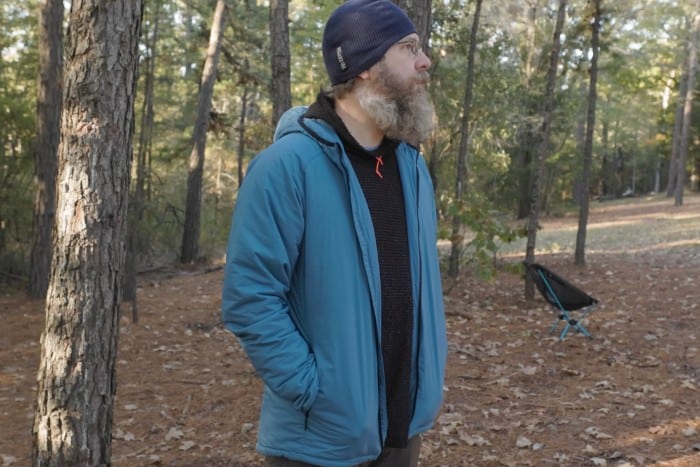
5. Prepare for Wet Clothes
Another thing to remember when packing your clothes is that they’ll eventually get wet.
It might be tempting to throw them into a heap in the corner of your tent so you can return to the fun activities, but this can be problematic.
Wet clothes won’t dry properly if tossed in a ball inside your tent, even if it is cozy and warm. Instead, they’ll stay wet and may grow a mildew smell.
Bring a clothesline to string up beneath a tarp so that you can air clothes out and help them to dry.
If this isn’t an option, try placing your damp clothes in your sleeping bag at night, where your body heat will do the heavy lifting to dry your clothes.
Initially, it might be a bit uncomfortable, but you’ll have dry and warm clothes to change into in the morning!
Also, don’t forget to read our article on the best camping sleeping bags to buy a great one.
6. Cover the Ground
One of the most important things you need to do when setting up camp in the rain is to protect yourself from the cold, wet ground. Before you pitch a tent, be sure to put a tarp down under the tent.
This will keep water on the ground from pooling up and making the floor of your tent wet. However, it’s important to note that this isn’t always a foolproof means of staying dry.
If you’ll be camping in the rain, you need to bring along a few other gears that will help you and your sleeping bag stay dry at night. First, you’ll want a sleeping pad to keep your body off the wet ground.
A sleeping pad pulls double duty, though. If it has a high R-value, it keeps your body heat from transferring to the cold ground beneath you.
You can read our article on the best camping sleeping pad to find some awesome options!
If you can’t afford a sleeping pad with a high R-value (because they can sometimes be a bit expensive), try doubling up on thinner sleeping pads or bringing an air mattress.
7. Use a Bivy Bag
Consider investing in a bivouac sack when sleeping pads or air mattresses aren’t an option.
Also known as a bivy sack or a bivy bag, this is a single-person covering that gives you some protection from wet surroundings.
Many people use bivy bags when they want to do tentless camping, but they can be equally useful when the weather worsens.
Bivy sacks are made of waterproof material on the bottom and waterproof but still breathable material on top. You will lay it on the ground and place your sleeping bag inside. Zip it up and head to sleep.
Rest assured that it will keep you, your sleeping pad, your pillow, and even a small backpack warm and dry throughout a cold and rainy night.
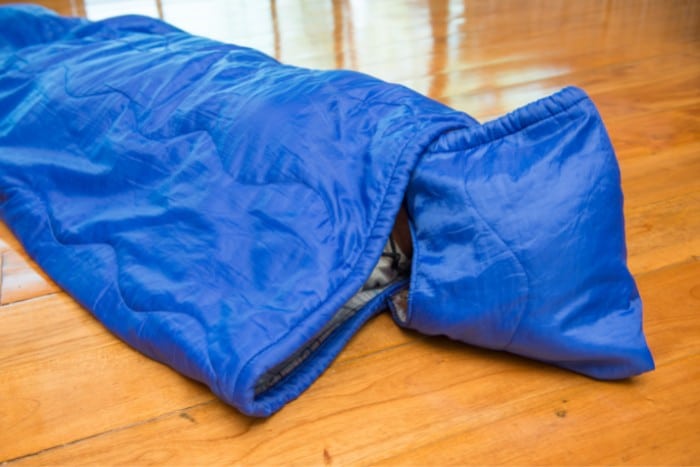
8. Invest in a Pair of Gaiters
If you plan to do more camping excursions in inclement weather, you should consider investing in quality gaiters to keep your pants dry around the campsite and on hikes.
Low gaiters can keep rain from getting into the boots from the top, while taller gaiters can keep your entire lower leg dry.
When combined with a poncho or a long rain jacket, you’ll have a simple and easy way of staying dry all over.
Even if you’ll just be hanging around the campsite, gaiters just below the knees can be great for keeping your pants dry and preventing you from getting overly chilled from the rain.
Keep in mind that gaiters aren’t necessarily a one-size-fits-all solution. Pay attention to how they connect to your boots or insteps.
If you can, try them on to make sure they hug your calves in a way you find comfortable because you’ll be wearing them for a while.
9. Pack a Rainfly
Don’t leave home without your rainfly! Many tents come with a rainfly, or you can buy one separately.
You want a rainfly that is a little larger than the overhead of your tent to prevent rain from blowing in from the sides.
An inexpensive tarp could also get the job done if your tent didn’t come with a rain fly. Remember that you want to keep the rain out as much as possible.
You might have to forgo the breeze that passes through open windows. Zip everything shut as much as possible to keep rainwater from sneaking in when the wind blows.
Alternatively, you could tie out a tarp or rainfly that is so large that it couldn’t possibly allow water in through the windows and vents.
10. Waterproof Your Tent
Even if you have a rainfly or a tarp situated over your tent, it’s important to ensure that your tent is as waterproof as possible.
This requires some prep work before you ever depart for the campground. Make sure the seams are all sealed to prevent water from leaking.
If you find that water can get in through the seams, use a seam sealer made for the unique fabric of your tent.
Additionally, adding a layer of waterproofing spray can make a non-waterproof tent a bit more resistant to rain. Make sure the tent is as clean as possible before application.
Then, take a sponge brush and gently apply the waterproofing spray to your tent. Give it adequate time to dry (sometimes several days) before you take it out in the rain.
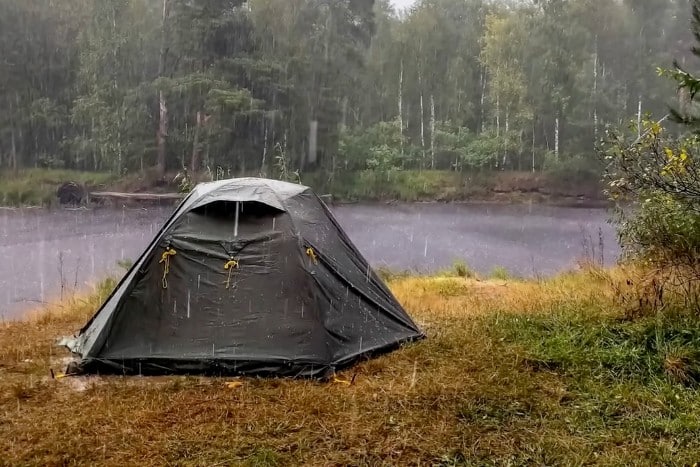
11. Pack the Right Food
Does anyone want to hover over a fire in the rain? Even if you can get it lit from wet foliage, you’ll likely encounter a smoky fire that fizzles out quickly with a sudden downpour.
One of the main reasons to stoke a fire is to cook your meals, so try to bring some foods that don’t require cooking or heating if you’ll be camping in the rain.
This can be a great time to bust out a camping stove if you need something to heat up for it to be edible. For example, you can use it to heat water for an MRE.
Read our article on the best camping stoves for some reliable options!
However, you might be better off packing foods that don’t require heat. Think cheese, meat, crackers, or peanut butter and jelly sandwiches.
It may not be the most glamorous meal you had at the campground, but you’ll be glad to have something nourishing to eat without tending to a dying fire in the rain.
12. Gather Dry Firewood
If you know it’s going to rain at some point throughout an extended camping trip, do your best to gather firewood right from the start.
Look for sticks and foliage that’s dry right now, and then stack it up under a tarp at the campsite. Make sure you have part of the tarp or a secondary top covering the ground.
This prevents water from wicking from the dirt into your firewood.
If it’s already wet and rainy upon arrival, you might consider stopping at the store to purchase some firewood to help you get started more easily.
Check with the campground first to ensure you’re allowed to bring your firewood from off-site. Of course, you must also ensure that you have something to start a fire.
Bring along some old newspaper or dryer lint to help you catch fire with your dry firewood. Alternatively, you may have to dig to find dry leaves and foliage that will kindle a fire.
13. Pack Towels
Even if you wear your rain gear 24/7, there’ll likely be a time when you still get wet and need to change out of your wet clothes. Keep your fresh clothes dry by bringing towels to dry off before changing.
Not to mention, you never know when you might get hit by an unexpected downpour. A set of quick-dry towels can help you to dry off before you get struck by the chill.
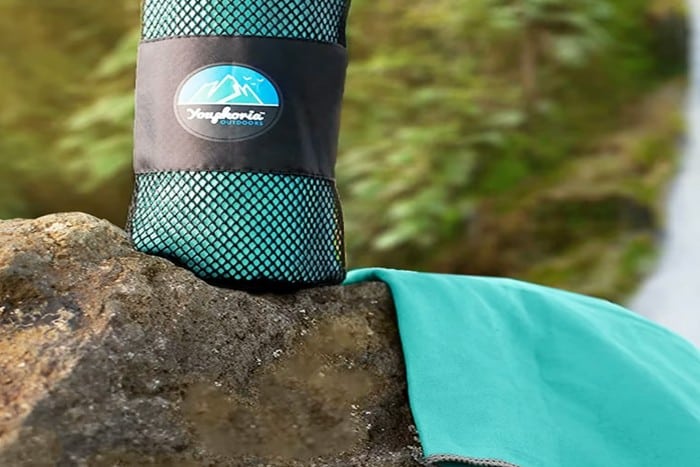
Final Thoughts
Camping in the rain can be a lot of fun, especially for those who like to practice their survival skills in the great outdoors.
With a little planning and an investment in some much-needed equipment, you can enjoy a rainy weekend around the campsite.
Take some tips and tricks to make your next camping experience more pleasant and comfortable, even in the wet weather!
